Discover the best cities in Spain for expat families as we go through the top family-friendly cities in Spain for digital nomads, freelancers, and remote workers. This 2025 guide compares cost of living, education, safety, healthcare, and lifestyle to help you find the best place to live in Spain with kids — pets included.

If you’re considering moving to Spain with your family while working remotely, you’re not alone. Spain has quickly become one of the top destinations in Europe for remote workers, freelancers, and digital nomads who want to combine quality of life with affordability, safety, and family-friendly infrastructure. This guide is specifically written for families who are either freelancing or working remotely and want to take advantage of Spain’s flexible visa options while finding the best city to live, thrive, and grow together.
As a single mom of two teenagers — one of whom is autistic — I’ve spent over a year researching where in Europe we could build a better life. After exploring a wide range of options (which I share in my guide to the best European countries for expat families working remotely), we’ve ultimately decided that Spain is the best fit for our family. Now, we’re in the process of narrowing down the right city — one that balances cost of living, safety, access to nature, and inclusivity.
Spain offers something for nearly every type of family: walkable cities, high-quality and affordable healthcare, excellent education, and a slower, more intentional pace of life. Families with neurodivergent children or who value progressive ideals will appreciate the social safety nets, healthcare access, and growing awareness around inclusion — particularly in medium to large cities. Spain is also known as one of the most LGBTQ+ friendly countries in Europe, which is important to our family, even if it’s not every family’s top priority.
We’re also pet parents, and like nearly 70% of families in the U.S., we want to make sure our dogs are welcome wherever we go. That includes checking airline regulations, housing rules, and the general attitude toward pets in each location.
Whether you’re looking for a vibrant big city, a laid-back coastal town, or a smaller urban center with a strong sense of community, this guide will help you explore the best cities in Spain for expat families — so you can find the one that feels most like home.

Why Spain Is One of the Best Countries for Remote Work Families in 2025
After months of research and soul-searching, Spain rose to the top of our list — and we’re not alone. For families who work remotely, Spain is one of the best countries in Europe to relocate in 2025. From its family-friendly cities and walkable neighborhoods to its public healthcare system and excellent education options, Spain offers the kind of balance many U.S. families are desperately seeking.
One of the biggest advantages Spain offers is its Digital Nomad Visa (DNV), launched in 2023. Unlike some countries that make it difficult for families to relocate long-term, Spain’s DNV allows you to legally live and work in the country as a freelancer or remote worker — and it extends to dependents as well. That means you can bring your kids and spouse with you and start building a life without jumping through impossible immigration hoops.
The cost of living is also a major draw. Compared to many parts of the U.S., expenses like housing, healthcare, and higher education are far more affordable. Cities like Valencia, Granada, and Valladolid offer a slower pace of life, a strong sense of community, and all the infrastructure families need — without the sky-high price tags you’ll find in other European countries.
For our family, it wasn’t just about affordability. We wanted a place where our neurodivergent daughter could thrive, where walking and public transit are the norm, and where inclusivity is more than just a buzzword. Spain checks those boxes. It’s one of the most LGBTQ+-friendly countries in Europe, with anti-discrimination laws and social attitudes that prioritize equality. And for families with pets, it’s a bonus that dogs are widely welcomed — in apartments, parks, and even on public transport in many cities.
Whether you’re a single parent, a homeschooling family, or just dreaming of a better work-life balance, Spain stands out as one of the best countries for expat families with remote jobs or freelance income in 2025 — and thanks to its digital nomad visa, it’s actually within reach.
Understanding Spain’s Digital Nomad Visa (DNV): How It Works for Families
Spain’s Digital Nomad Visa — launched in 2023 as part of the Start-Up Law — was one of the key reasons we seriously considered moving here. While many European countries offer long-stay or freelancer visas, Spain’s DNV is one of the few that clearly supports remote workers with families, allowing dependents to be included in your application from the start.
The DNV is designed for freelancers or remote workers who have clients or employers outside of Spain, which makes it ideal for U.S. families who already work online. If you’re self-employed or have contracts with foreign companies, and you can meet the income requirements, this visa can open the door to a new life in Spain — with access to healthcare, public schools, and long-term residency options.
Key Requirements for Spain’s Digital Nomad Visa
- Remote income from outside Spain: You must earn at least 80% of your income from companies or clients located outside of Spain.
- Minimum income: Roughly €2,520/month for the main applicant (200% of Spain’s minimum wage); add 75% (945) for the first dependent and 25% (315) for each additional one.
- Proof of experience: You need either a degree or three years of relevant work experience in your field.
- Work contract or freelance contracts: You’ll need to show a contract or client agreements that prove steady remote income.
- Full private health insurance: You must purchase private insurance with no co-pays or deductibles, valid across Spain.
- Criminal background check: From your country of residence and any country you’ve lived in during the past 5 years. (You can also use an online criminal records lookup tool to review your profile before applying for the visa.)
- Register as an autónomo: Once approved, you’ll need to register as a self-employed worker in Spain and pay into the social security system (which gives you access to public healthcare and other benefits).
Pros of Spain’s DNV for Families
- You can include your spouse and children on your application.
- You’ll have legal residency from the start, which makes enrolling kids much easier.
- Pathway to permanent residency and citizenship: Especially for citizens of Latin American countries, the Philippines, and a few others, Spain offers fast-track citizenship in just two years.

Challenges and Things to Be Aware Of
- Spain is known for bureaucracy and slow processing times, especially in major cities like Madrid and Barcelona.
- You will need to pay taxes in Spain once you’re a resident — even if your income comes from abroad. Make sure to consult a tax advisor to understand how this might affect you.
- Finding an apartment, especially as a family with pets, can be competitive and costly in popular expat cities like Valencia and Málaga.
- While DNV holders have legal residency, most public universities still consider them international students and charge non-EU tuition rates. Policies vary by region and institution, so it’s best to confirm directly with the university.
That said, for families like ours — who already have contracts, flexible remote work, and want a better quality of life — the Digital Nomad Visa is one of the most accessible and family-friendly visas in Europe.
Other Ways to Move to Spain as a Remote Working Family
While Spain’s Digital Nomad Visa is the most straightforward option for many remote-working families, it’s not the only one. Depending on your situation, there are other Spain visa options for freelancers and families that could make sense.
One key thing many visa applicants overlook is the need for a flight reservation or itinerary when submitting applications. If you’re not ready to purchase full tickets before approval, using a reputable onward ticket provider like Verifticket
allows you to obtain an acceptable booking reference without risking large upfront costs—helping satisfy documentation requirements without over‑committing financially.
Alternative Visa Options for Families Moving to Spain
- Non-Lucrative Visa (NLV): This is ideal for families who don’t need to work in Spain and have passive income or savings. You can’t legally work on this visa, including remote work — so it’s not a fit for most freelancers or digital nomads, but it’s popular with retirees or FIRE (Financial Independence, Retire Early) families.
- Autónomo Visa: Often used by freelancers, this visa overlaps with the DNV in that both require registering as self-employed (autónomo) and paying into Spain’s social security system. The main difference is that the autónomo visa is more complex and usually processed under local requirements rather than national ones.
- Student Visa: If your child is studying in Spain, one parent can usually apply to accompany them. This can be a creative option for families with college-age children.
- Family Reunification Visa: If you have a spouse or close family member who is already a resident or citizen, you may be eligible to join them.
❗ Important Note: Spain’s Golden Visa, which allowed non-EU citizens to gain residency by investing €500,000+ in real estate, is expected to be discontinued by April 2025. If you’ve heard about this route, know that it’s being phased out and likely won’t be available for much longer.
While these other pathways might work for some families, most remote-working families with freelance income or contracts will find the Digital Nomad Visa to be the most realistic and flexible option.
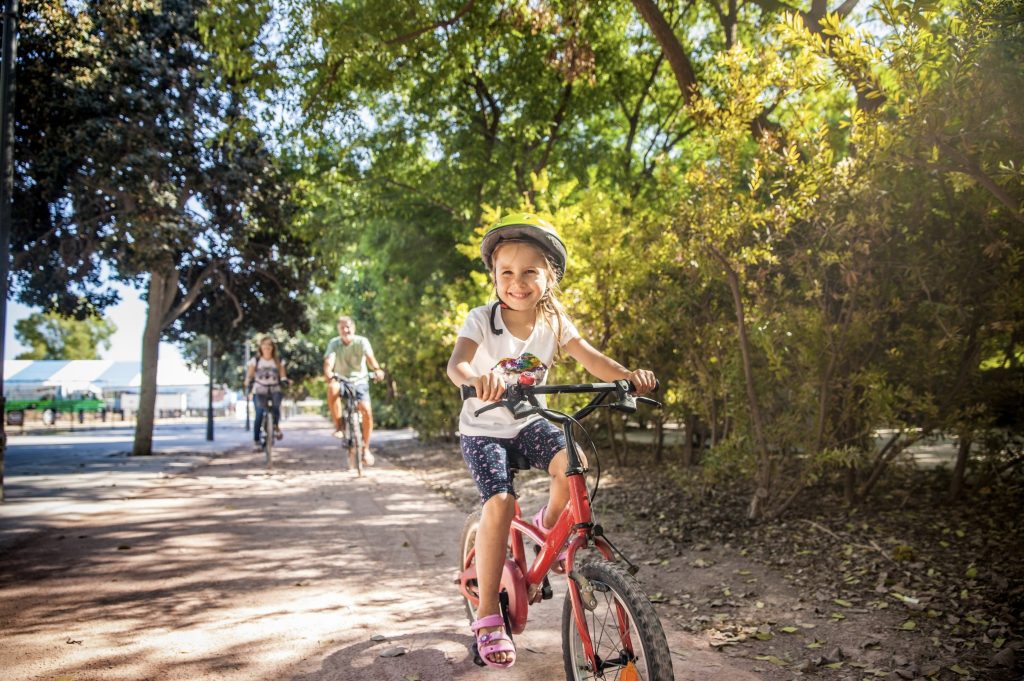
How to Use This Guide: Choosing the Best City in Spain for Expat Families
This guide is designed for families who are planning to live in Spain while working remotely — especially those who are applying for Spain’s Digital Nomad Visa, or freelancing with international clients. Whether you’re a single parent like me, a two-parent household, or a family with teens or younger kids, you’ll find useful insights to help you choose the city that best fits your lifestyle and values.
We looked at a wide range of factors when selecting the best cities in Spain for expat families, including:
- Safety and walkability
- Public transportation and access to green spaces
- Affordability and availability of housing (especially rentals that allow pets)
- Quality of education, including international schools and nearby universities
- Healthcare access and services for neurodiverse children or children with disabilities
- Climate and air quality
- Presence of expat communities and support networks
- Proximity to international airports and transportation hubs
- Cultural richness, diversity, and language dynamics (including Catalan, Galician, and Basque regions)
We’ve included a mix of large cities, mid-sized urban centers, and lesser-known gems to reflect different priorities: some families might prioritize international schools and easy flights to the U.S., while others are looking for a quieter pace of life with better housing options and less tourism.
Each city profile includes real insights from our own travels, research from expat groups and local data, and what daily life could actually look like for a family with pets, teenagers, and a remote-working parent. And while we are providing a list of the best cities in Spain for expat families, the ideal city for your family will depend on your priorities!
This guide is a follow-up to my comprehensive post on the Best Countries in Europe for Remote-Working Families — so if you’re still deciding which country is the best fit, make sure to check that out too!
Madrid: Big-City Energy with World-Class Culture and Family Perks
Madrid was one of the first places I visited in Spain with my kids, and it immediately pulled us in. Walking around the city felt like stepping into a vibrant, international hub — with something for every age and interest. Museums, green spaces, amazing food, and public transportation that actually works made it feel like a completely different lifestyle from what we’re used to in Florida. While the summer heat and tourist crowds were intense, I loved how alive the city felt — and how walkable it was despite being a capital.
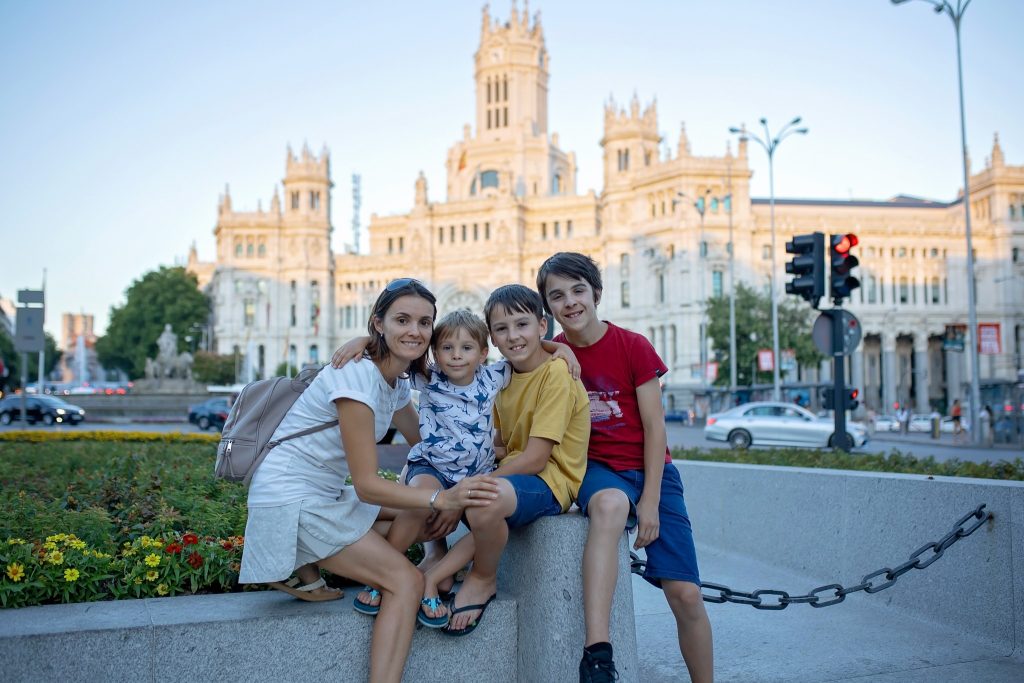
For families, Madrid offers the best of both worlds: the diversity and services of a large city, paired with excellent education, healthcare, and culture. My daughter especially loved the food scene, and both my kids noticed how safe and easy it was to get around without a car — something that’s almost impossible in many parts of the U.S.
Why Families Love It
- World-class education: Madrid has some of the top international and bilingual schools in Spain, plus top-rated universities like Universidad Autónoma de Madrid and Universidad Complutense.
- Green spaces galore: With huge parks like Retiro and Casa de Campo, there are endless options for picnics, playgrounds, and family bike rides.
- Reliable public transportation: The metro system is clean, safe, and easy to navigate — a complete game-changer for families used to car-dependent cities.
- Access to everything: Madrid is extremely well-connected, with fast trains (AVE) to other Spanish cities and an international airport with nonstop flights to the U.S.
- Cosmopolitan and diverse: From food to culture to people, Madrid feels like a true international city while still maintaining its Spanish charm.

What to Consider
- Higher cost of living: Rent and general expenses are noticeably higher than in smaller Spanish cities, especially in family-sized apartments.
- Bureaucracy moves slowly: From visa paperwork to registering your kids in school, things tend to take longer in large cities like Madrid and Barcelona.
- Summer heat and tourism: July and August can be brutally hot, and tourist crowds can make the city feel overwhelming.
- Neighborhood choice matters: Some areas are very touristy, while others are more residential and family-friendly — neighborhoods like Chamberí, Retiro, and Salamanca are often recommended for expat families.
Madrid: Estimated Cost of Living for a Family of Four (2025)
A family of four in Madrid can expect to spend approximately €3,800–€4,800/month, including:
- Rent for a 3-bedroom furnished apartment: €1,800–€2,500
(based on central and family-friendly neighborhoods like Retiro or Chamberí) - Essentials: groceries, utilities, internet, public transportation, dining out, and healthcare
- Education: public schools are free; international school tuition varies
Best For: Families who want city energy, top-tier cultural and educational options, and easy access to the rest of Spain and Europe — and who are comfortable navigating big-city life.
Barcelona: A Vibrant, Artsy City with Mediterranean Views — and Big-City Tradeoffs
Barcelona is one of the most iconic cities in Spain — and it’s easy to see why. The moment you arrive, you’re surrounded by jaw-dropping architecture, creative energy, and the laid-back vibe of the Mediterranean. When I visited with my teens, we were all struck by how stunning and unique the city felt. Between the Gaudí buildings, the beaches, and the artistic energy everywhere, it was unforgettable. If you’re arriving early or leaving late and want to explore without your bags, luggage storage in Barcelona can make your day much easier.

But we also noticed how overwhelming Barcelona can be — especially in summer. It’s one of the most touristy cities in Europe, and while that comes with great infrastructure and global diversity, it can also make day-to-day life feel hectic. Still, Barcelona has a lot to offer families — especially those who value culture, walkability, and international connectivity.
Why Families Love It
- Top-tier education: Barcelona has a wide range of international and bilingual schools, including IB programs, and strong universities like Universitat de Barcelona and Pompeu Fabra.
- Incredible public transport: You can get around easily via metro, tram, bus, and regional trains — no car needed.
- Parks and beaches: You’ll find beautiful green spaces like Parc de la Ciutadella, plus city beaches perfect for weekend downtime.
- Diverse, global community: With expats from around the world, Barcelona is welcoming and multicultural.
- World-class culture and food: From museums and theaters to tapas and local markets, the cultural richness is unbeatable.

What to Consider
- Tourism and crowds: In the summer, the city can feel packed and noisy, especially in the center.
- High cost of living: Rent prices have skyrocketed in recent years, and it’s increasingly difficult to find affordable, family-sized apartments — especially with pets.
- Language barriers: While Spanish is widely spoken, Catalan is the primary language in public schools and many signs and official documents. This can be a challenge for families planning to enroll in the local system.
- Safety: Barcelona is safe overall, but petty theft and pickpocketing are more common than in smaller cities.
Barcelona: Estimated Cost of Living for a Family of Four (2025)*
A family of four in Barcelona can expect to spend approximately €3,900–€4,900/month, including:
- Rent for a 3-bedroom furnished apartment: €1,800–€2,600
(based on neighborhoods like Gràcia, Eixample, or Poblenou) - Essentials: groceries, utilities, internet, public transportation, dining out, and healthcare
- Education: public schools are free; international school tuition varies
Best For: Families who want a vibrant, creative city with beaches, international schools, and strong connectivity — and who don’t mind crowds, high rent, or navigating a bilingual region.
Valencia: The Greenest City in Europe and One of the Best for Expat Families
Valencia has steadily become one of the most popular cities in Spain for expat families — and after visiting, it’s easy to understand why. It’s a mid-sized city with the cultural richness of Barcelona or Madrid, but with a slower pace, better affordability, and more green spaces. For our family, it’s at the top of our list as one of the best cities in Spain for expat families. The contrast between the historic city center and the futuristic architecture of the Ciudad de las Artes y las Ciencias makes Valencia feel both timeless and forward-thinking.
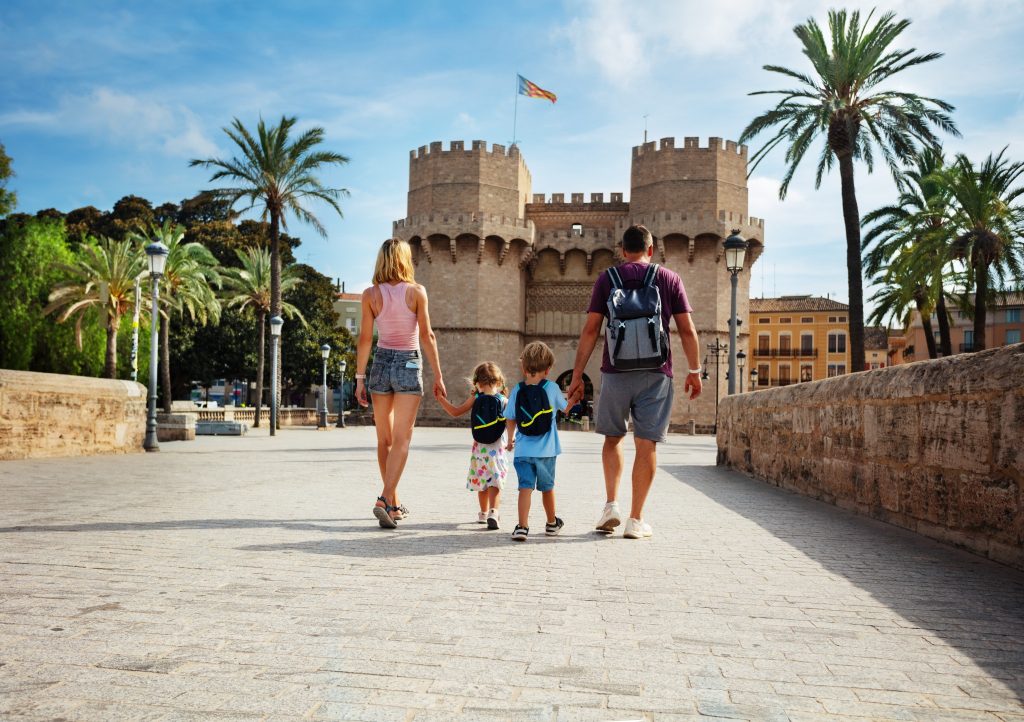
It’s also incredibly walkable and bike-friendly, with a flat layout and parks spread throughout the city — including Turia Park, a 9-kilometer-long green space that was once a riverbed. As a birder and nature lover, I was amazed by how much access there is to nature both inside and just outside the city, including Albufera Natural Park. My teens loved how easy it was to get around, and for families with neurodivergent or LGBTQ+ kids, Valencia offers progressive values, supportive services, and a welcoming atmosphere.
Why Families Love It
- Excellent public and private schools: A strong mix of local, bilingual, and international options — including schools with experience supporting neurodivergent students.
- Green spaces galore: Declared the European Green Capital, Valencia offers some of the most accessible and abundant parks in any Spanish city.
- Great healthcare and services: Known for its efficient public services and medical care.
- Bike-friendly and walkable: Extensive bike lanes, a flat landscape, and pedestrian-friendly design make it ideal for families without a car.
- Strong expat community: There’s a large and growing international community, especially in neighborhoods like Ruzafa and El Carmen.

What to Consider
- Housing shortages: Valencia is experiencing a housing crunch. Apartments, especially those that are pet-friendly or large enough for families, can be hard to find — and more expensive than expected.
- The Fallas Festival: Every March, Valencia celebrates its famous Fallas with fireworks day and night. While fun for some, it can be overwhelming for others (especially neurodivergent kids or dogs). Many locals even leave the city during this time.
- Bilingual region: Valencian (a dialect of Catalan) is used in public education and some signage, so keep this in mind when researching schools.
- Tourism is growing: While not as crowded as Barcelona, Valencia has become very popular with expats and digital nomads, which can affect housing and rental prices.
Valencia: Estimated Cost of Living for a Family of Four (2025)*
A family of four in Valencia can expect to spend approximately €3,300–€4,200/month, including:
- Rent for a 3-bedroom furnished apartment: €1,500–€2,000
(based on neighborhoods like Ruzafa, Cabanyal, and El Botànic) - Essentials: groceries, utilities, internet, public transportation, dining out, and healthcare
- Education: public schools are free; international school tuition varies
Best For: Families who want a balance of affordability, nature, and vibrant culture in a walkable, bike-friendly, and welcoming mid-sized city with great services and a growing expat community.
Malaga: Coastal Charm, Sunshine Year-Round, and a Booming Expat Community
Malaga is often one of the first cities recommended to expats moving to Spain — and that is why we had to include it in our list of the best cities in Spain for expat families. With over 300 days of sunshine a year, a vibrant food scene, and an unbeatable location on the Costa del Sol, it offers that dreamy Mediterranean lifestyle many families are searching for. But there’s more to Malaga than just beaches and palm trees.

The reason why I believe Malaga is one of the top contenders when it comes to the best cities in Spain for expat families was how well it blends tradition with modernity. You’ll find centuries-old castles and cathedrals right alongside new coworking hubs, international schools, and cutting-edge cultural centers like the Pompidou. For families, Malaga offers an inviting mix of laid-back living, walkability, and access to nature — plus a large international community that makes it easier to settle in.
Why Families Love It
- International schools and public options: Several bilingual and international schools, including British and French curriculums.
- Mild winters, lots of sunshine: One of the sunniest cities in Europe, ideal for families who prioritize good weather and outdoor living.
- Beach + mountains: You get the best of both worlds — coastline for swimming and sailing, and mountains for hiking and weekend getaways.
- Strong public transport: While the metro system is limited, local buses and regional trains (including high-speed AVE service) make getting around easy.
- Active expat network: Malaga has become a magnet for digital nomads and international families, especially in neighborhoods like El Limonar and Pedregalejo.
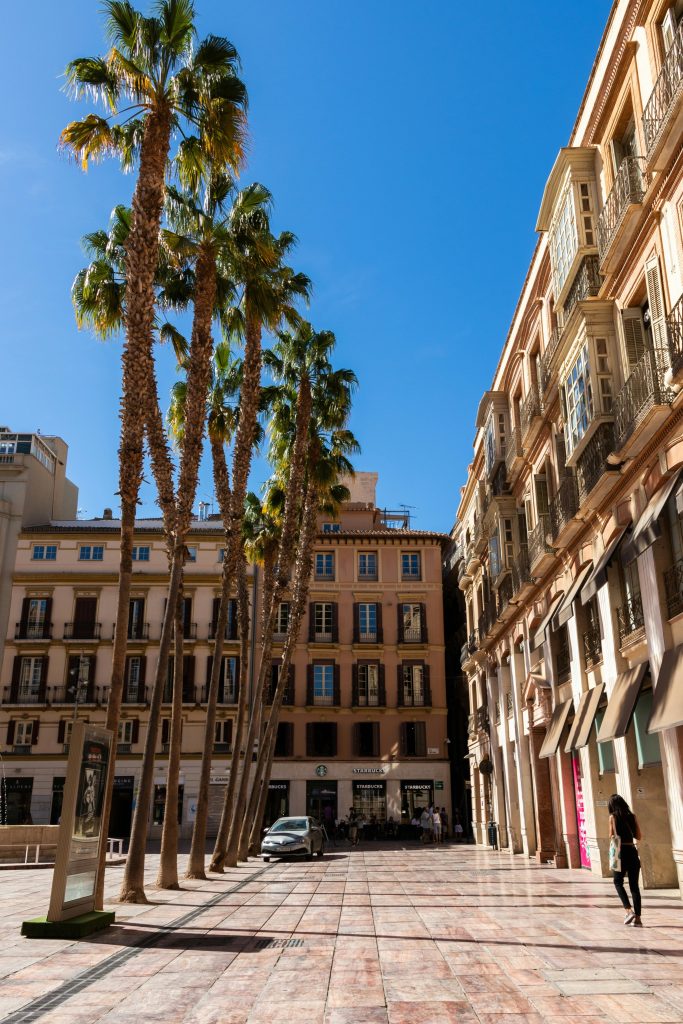
What to Consider
- Housing demand is high: Like Valencia, Malaga is facing a competitive rental market. Family-sized, pet-friendly housing close to the beach can be expensive and hard to find.
- Tourist crowds in summer: While still more relaxed than Barcelona or Madrid, summer months can get very busy and prices often rise seasonally.
- Public education varies: Schools are generally good, but the quality can vary by district — something to keep in mind when choosing a neighborhood.
- Some areas are very hilly: While many neighborhoods are walkable, others (especially those with great sea views) are harder to navigate without a car or solid public transport access.
Malaga: Estimated Cost of Living for a Family of Four (2025)*
A family of four in Malaga can expect to spend approximately €3,100–€4,000/month, including:
- Rent for a 3-bedroom furnished apartment: €1,400–€1,900
(based on neighborhoods like El Limonar, Teatinos, and Pedregalejo) - Essentials: groceries, utilities, internet, public transportation, dining out, and healthcare
- Education: public schools are free; international school tuition varies
Best For: Families looking for sun-filled living, Mediterranean beaches, and a relaxed lifestyle with strong international school options and an active expat community.
Granada: Old-World Charm, Lower Costs, and a Slower Pace of Life
Granada is one of those cities that stays with you. Tucked at the base of the Sierra Nevada mountains in Andalusia, it offers a magical blend of Moorish architecture, historic neighborhoods, affordable living, and a slower, more intentional pace of life. While it’s smaller than cities like Malaga or Valencia, Granada made it into our list of the best cities in Spain for expat families because it still has everything a family needs — plus a unique character that feels unlike anywhere else in Spain.
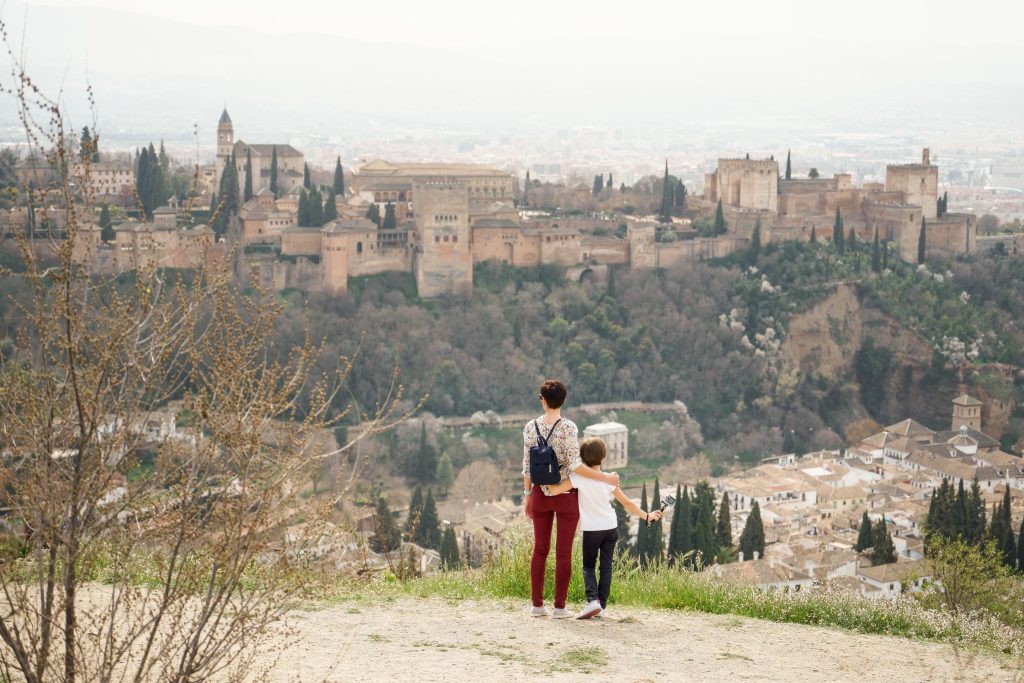
Granada stands out as one best cities in Spain for expat families who want a more immersive Spanish experience with less tourism, lower costs, and beautiful surroundings, Granada is an underrated gem. The city is also home to one of Spain’s top public universities, which gives it a vibrant energy without the hustle of larger metros. With beautiful parks, cozy plazas, and the Alhambra as your backdrop, daily life here feels like something out of a storybook.
Why Families Love It
- Low cost of living: One of the most affordable cities on this list, with family housing options well under €1,200/month.
- Beautiful, walkable city center: You can walk almost everywhere — from local markets to parks, cafés, and historic sites.
- Strong public health system: Despite its smaller size, Granada has excellent healthcare facilities and public hospitals.
- University city vibe: Home to the University of Granada, which brings a youthful, international energy — but not in a party-heavy way.
- Proximity to nature: Quick access to hiking, skiing in the Sierra Nevada, and beaches just an hour away on the Costa Tropical.
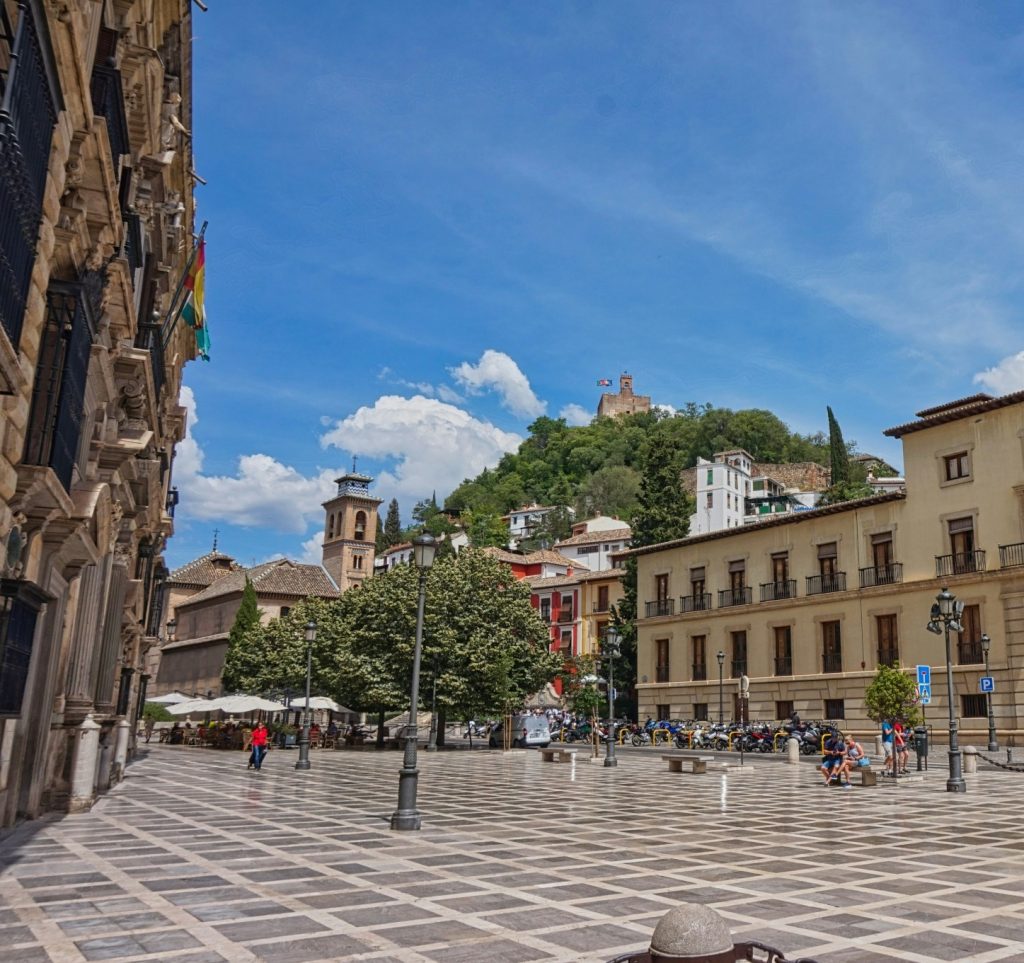
What to Consider
- Limited international school options: Most schools are Spanish-speaking; there are very few international or bilingual programs, which could be a challenge for non-Spanish-speaking kids.
- Hot summers, chilly winters: Granada has dry, very hot summers and surprisingly cold winters due to its elevation — something to keep in mind if you prefer mild year-round weather.
- Less expat support: Compared to bigger cities, there’s a smaller expat community, which might feel isolating for some families at first.
- Fewer English speakers: Day-to-day life requires more Spanish, especially when navigating healthcare, education, and government systems.
Granada: Estimated Cost of Living for a Family of Four (2025)*
A family of four in Granada can expect to spend approximately €2,400–€3,200/month, including:
- Rent for a 3-bedroom furnished apartment: €950–€1,400
(based on centrally located, family-friendly neighborhoods like Realejo and Zaidín) - Essentials: groceries, utilities, transportation, entertainment, and private health insurance
- Education: public schools are free; private and bilingual options are budget-friendly
Best For: Families seeking a slower pace of life, a deep cultural experience, and lower living costs — with easy access to mountains, nature, and traditional Spanish charm.
Alicante: Coastal Comfort and Affordability on the Costa Blanca
Alicante might not get as much attention as Valencia or Malaga, we had to include it in the best cities in Spain for expat families because it’s one of Spain’s hidden gems, and often underrated. Located on the southeastern coast, Alicante blends that dreamy Mediterranean lifestyle with a lower cost of living, great weather, and a growing international community. Families will love its sandy beaches, relaxed pace, and compact, walkable city center.
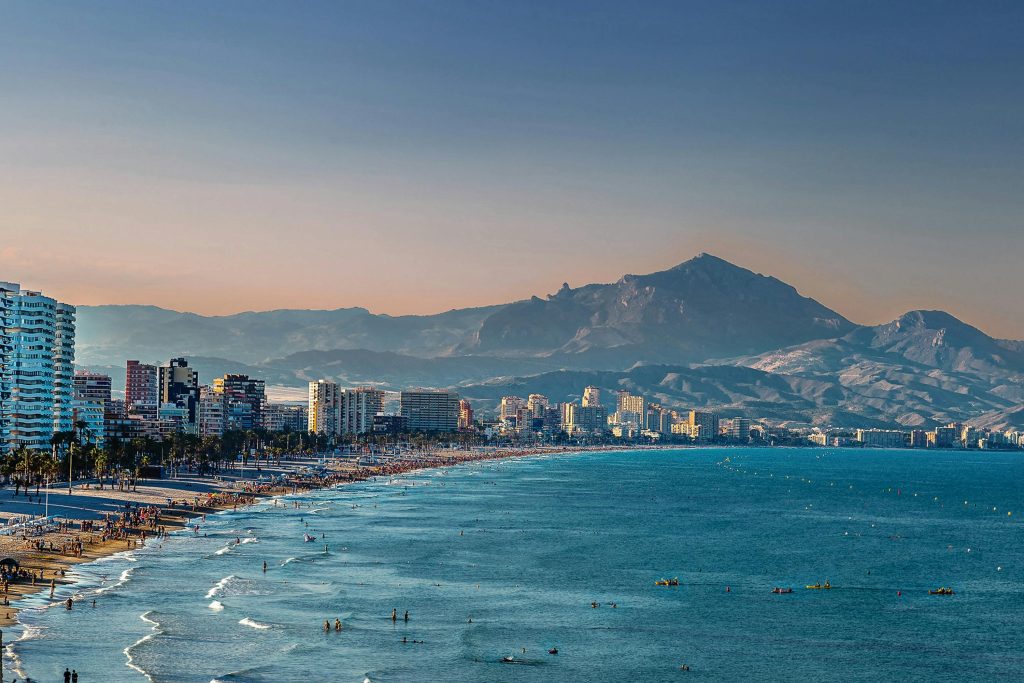
What made Alicante stand out for us is how manageable it feels. You get the benefits of a coastal city without the overwhelm of a larger metro area. There’s solid public transportation, international and bilingual schools, family-friendly beaches, and lots of sunshine — all of which make day-to-day life easier. Plus, it’s one of the more affordable places to live in Spain that still offers a good mix of amenities.
Why Families Love Alicante
- Family-friendly beaches: Calm waters and wide shorelines like Playa del Postiguet are great for younger kids.
- Great weather: With over 300 days of sunshine a year, Alicante makes it easy to spend more time outdoors.
- More affordable housing than bigger cities, especially in neighborhoods like San Juan and Albufereta.
- Walkable city center and safe tram network that makes getting around easy without a car.
- Strong expat community with meetups, resources, and support groups.
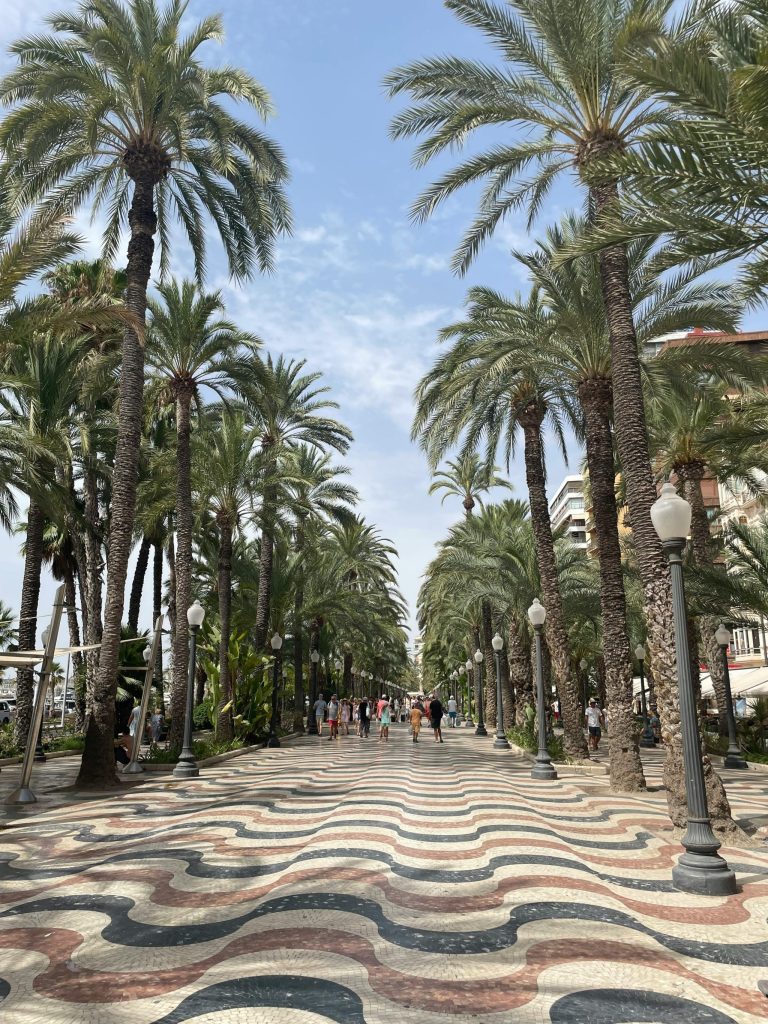
What to Consider
- Public school instruction includes Valencian (a dialect of Catalan), which may be a challenge if your kids are still learning Spanish.
- Summer heat and tourism: July and August are busy and hot, especially near the beaches.
- Fewer international school options compared to larger cities, though good bilingual programs are available.
- Housing availability improving, but pet-friendly rentals can still be competitive.
Alicante: Estimated Cost of Living for a Family of Four (2025)*
A family of four in Alicante can expect to spend approximately €3,000–€4,000/month, including:
- Rent for a 3-bedroom furnished apartment: €1,100–€1,600
(based on family-friendly areas like San Blas, Playa de San Juan, and Albufereta) - Essentials: groceries, dining, public transportation, healthcare, and entertainment
- Education: public schools are free; private school options are limited but affordable
Best For: Families looking for a relaxed, beachy lifestyle with lots of sunshine, affordable housing, and a supportive (but less overwhelming) expat scene.
Bilbao: Modern Infrastructure, Green Living, and a Distinct Northern Vibe
Located in the heart of the Basque Country, Bilbao offers a completely different flavor of Spain — one that’s modern, green, and deeply tied to its unique regional identity. Once an industrial city, Bilbao has transformed into a hub of innovation and design, with world-class museums like the Guggenheim, cutting-edge public transport, and a strong sense of community. It’s less touristy than Madrid or Barcelona, which gives families a more grounded, local experience.

What makes Bilbao stand out in this best cities in Spain for expat families is how well it balances city life with nature. You’re surrounded by mountains, just a short drive from the beach, and the city itself is filled with parks, bike paths, and pedestrian-friendly streets. It’s safe, organized, and often overlooked — making it one of the best hidden gems for families who want excellent public services and a quieter expat life.
Why Families Love Bilbao
- Top-tier public services: Healthcare, education, and transportation are reliable and well-funded.
- Less tourism, more authenticity: Ideal for families who want to integrate into the local culture.
- Close to nature: Hiking, surfing, and weekend beach trips are all within reach.
- Strong regional identity: Basque culture is vibrant, and the food scene is exceptional.
- Green city initiatives: One of Spain’s most sustainable and environmentally friendly cities.
What to Consider
- Language: Basque (Euskara) is widely spoken alongside Spanish, especially in schools. This can be an adjustment for families unfamiliar with the region.
- Rainier climate: Bilbao gets significantly more rain than other Spanish cities, especially in winter.
- Smaller expat community: Great for immersion, but international support networks are more limited than in cities like Madrid or Valencia.
- Cost of living is moderate: Less expensive than Madrid or Barcelona, but not as affordable as Granada or Valladolid.
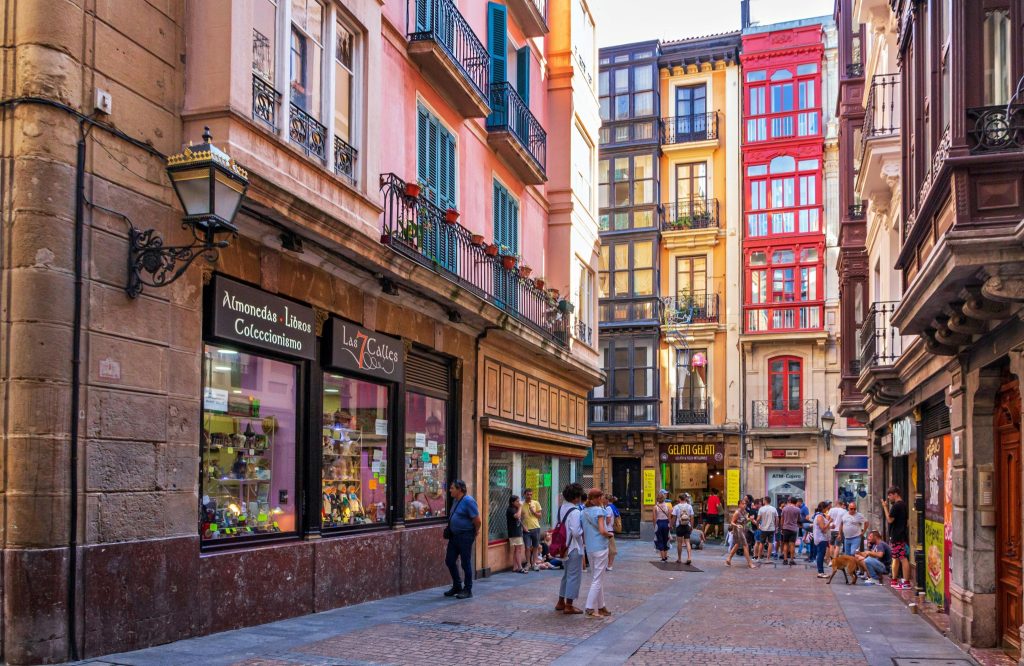
Bilbao: Estimated Cost of Living for a Family of Four (2025)*
A family of four in Bilbao can expect to spend around €3,100–€4,100/month, including:
- Rent for a 3-bedroom furnished apartment: €1,100–€1,700
(based on family-friendly neighborhoods like Indautxu, Deusto, and Abando) - Essentials: groceries, dining out, public transport, utilities, and basic healthcare
- Education: public schools are free; some bilingual and semi-private schools available
Best For: Families who want a modern, clean, and safe environment with strong public services and easy access to both beach and mountain adventures — and who are open to learning about and living within a distinct regional culture.
Tenerife: Island Life, Outdoor Living, and Family-Friendly Communities
Tenerife, the largest of Spain’s Canary Islands, offers a lifestyle that’s hard to beat — especially if your family values nature, sunshine, and a slower pace. Known for its year-round spring-like weather, beautiful beaches, and dramatic volcanic landscapes, Tenerife is, without a doubt, one of the best cities in Spain for expat families and digital nomads who want the benefits of Spanish living with a tropical twist. But it’s not just a vacation spot — it’s a surprisingly practical option for families, too.
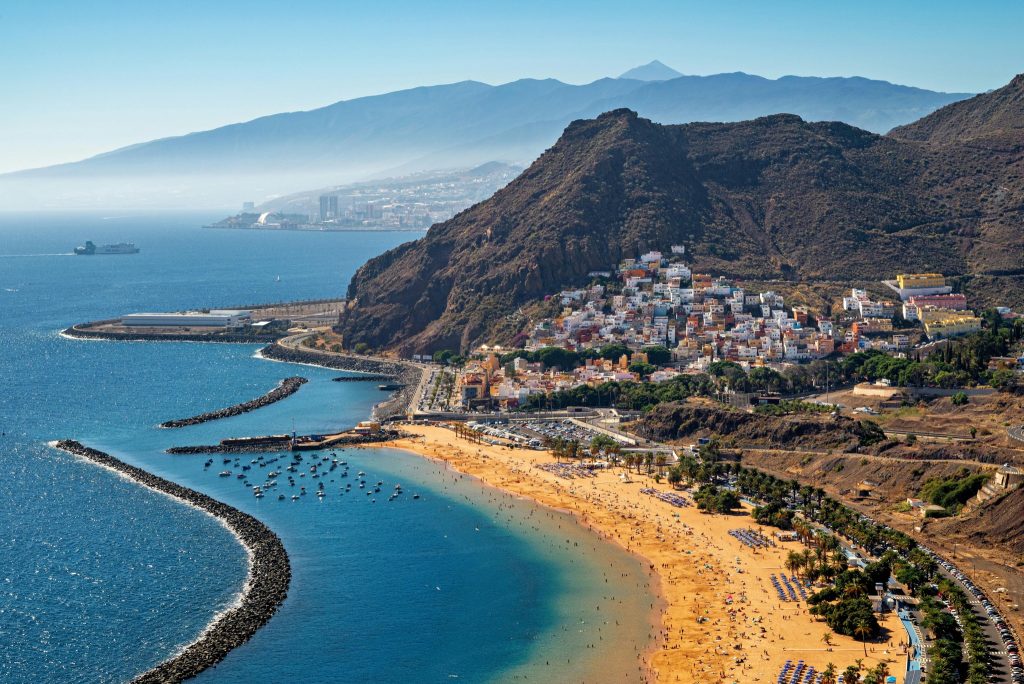
What stood out most to me about Tenerife is how much it has to offer beyond its reputation as a tourist destination. From bilingual schools and international communities to family-friendly coastal towns and plenty of green space, it’s one of the few places where you can hike a volcano in the morning, do school runs in the afternoon, and hit the beach at sunset — all without spending a fortune.
Why Families Love Tenerife
- Ideal climate: Mild and sunny all year long — no winter coats or snow boots required.
- Affordable cost of living: Rents and groceries tend to be lower than mainland Spain.
- Outdoor lifestyle: Mountains, beaches, forests, and volcanoes are your playground.
- Welcoming expat community: Especially strong in areas like Puerto de la Cruz and Adeje.
- Slower pace of life: Great for families looking to unplug and reset.
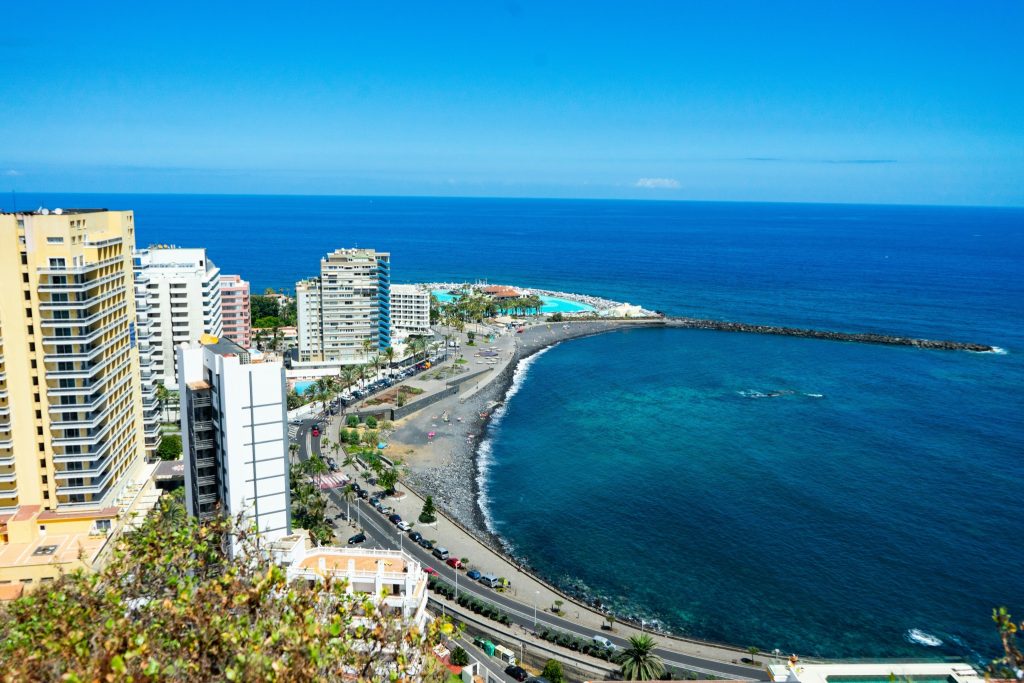
What to Consider
- Island logistics: Flights to the mainland and international destinations are frequent but can get pricey during peak seasons.
- Fewer big-city amenities: While the island has everything you need, it lacks the density of services found in larger cities.
- Public transportation: Adequate in urban centers but limited in more rural or suburban areas — having a car is often essential.
- School options vary: Public schools are available, and there are a few bilingual or international schools, but options are more limited than in major cities.
- Less anonymity: The expat community is close-knit, which can be a plus or a minus depending on your preference.
Tenerife: Estimated Cost of Living for a Family of Four (2025)*
A family of four living in Tenerife can expect to spend approximately €2,800–€3,800/month, including:
- Rent for a 3-bedroom furnished apartment: €900–€1,500
(based on family-friendly neighborhoods like La Laguna, Santa Cruz, and Puerto de la Cruz) - Essentials: groceries, utilities, dining out, transportation, and healthcare
- Education: public schools are free; some bilingual and private schools are available
Best For: Families who want a warm, nature-filled lifestyle, lower living costs, and a close-knit expat community — and don’t mind the trade-offs that come with island living.
Zaragoza: Affordable Living, Central Location, and Authentic Spanish Charm
Zaragoza may not be the first city that comes to mind when thinking about the best cities in Spain for expat families to move to — but for families, it might just be one of the country’s best-kept secrets. Nestled between Madrid and Barcelona, this mid-sized city offers the perfect balance of affordability, safety, walkability, and access to nature. It has all the infrastructure of a larger city — great healthcare, solid public transportation, and quality education — without the high price tag or overwhelming crowds.
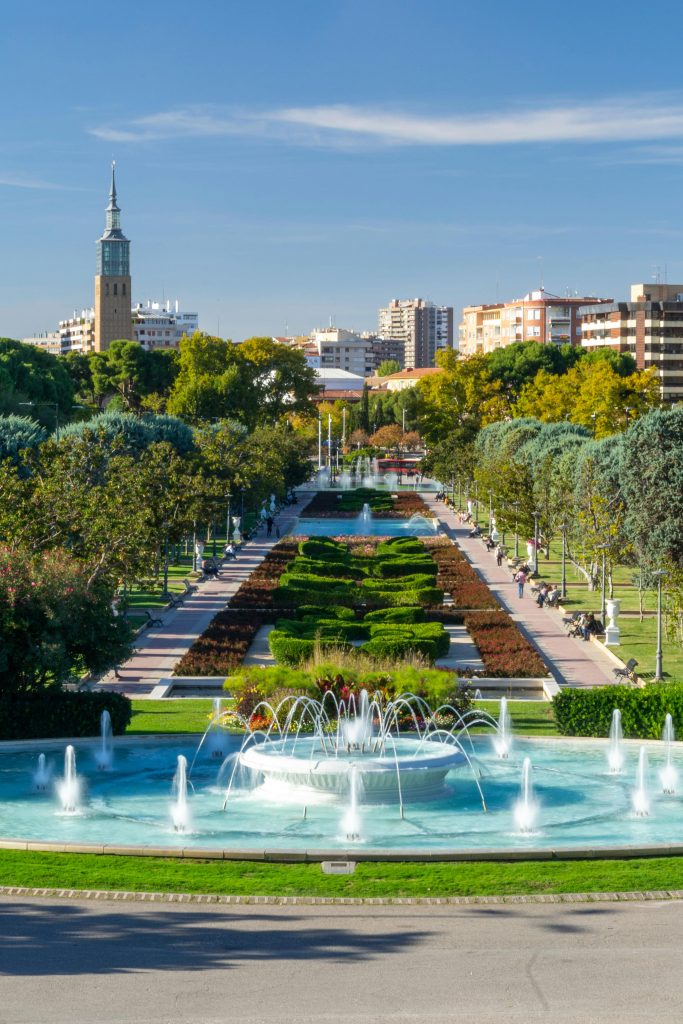
What really stood out to me about Zaragoza is its local feel. It’s a real Spanish city, not one overly catered to tourists or digital nomads, which means families looking to immerse themselves in the culture will find it incredibly rewarding. It’s clean, calm, and has a slower pace of life — exactly what many families are craving.
Why Families Love Zaragoza
- Low cost of living: Rent, food, and daily expenses are significantly lower than in Spain’s big three cities.
- Great location: High-speed AVE trains connect you to Madrid and Barcelona in under 1.5 hours.
- Walkable city center: With wide boulevards, historic sites, and plenty of green space, it’s easy to get around without a car.
- Excellent healthcare: Zaragoza has some of the top-rated hospitals and clinics in Spain.
- Fewer tourists, more authenticity: Live like a local and enjoy a quieter, more traditional lifestyle.
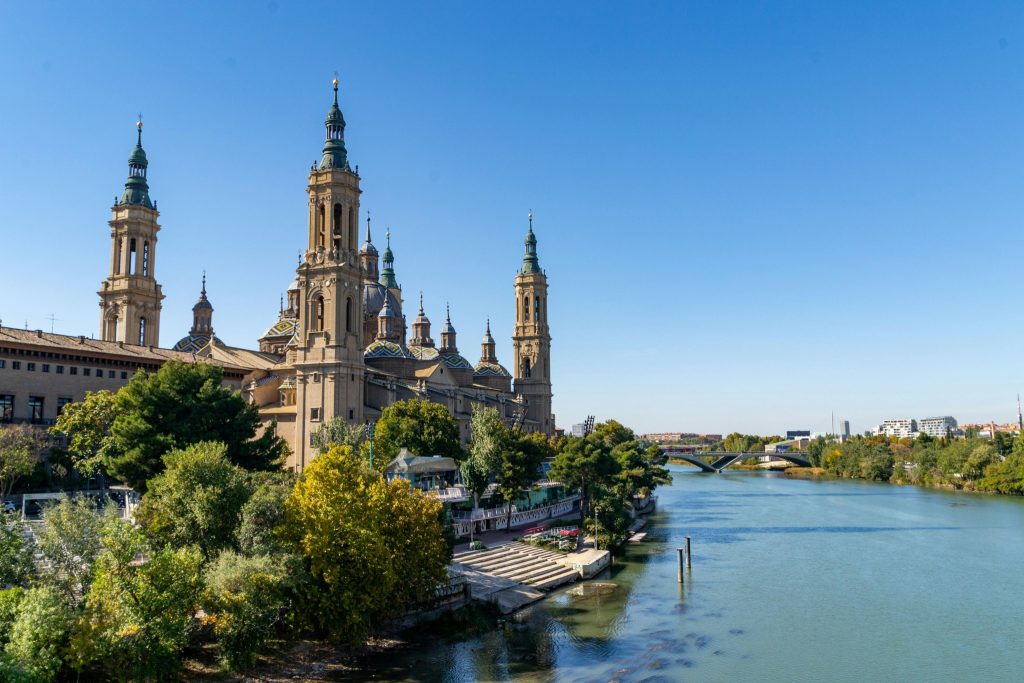
What to Consider
- Smaller expat community: You’ll find fewer international families than in coastal or major cities.
- Education language: Public schools use Spanish, with little English spoken outside international settings. Great for immersion, but could be a hurdle for newcomers.
- Colder winters: Zaragoza gets hot in the summer and cold in the winter — not extreme, but something to consider if you’re chasing year-round warmth.
- Limited international school options: There are a couple of bilingual private schools, but fewer international options compared to cities like Madrid or Valencia.
Zaragoza: Estimated Cost of Living for a Family of Four (2025)*
A family of four in Zaragoza can expect to spend approximately €2,700–€3,500/month, including:
- Rent for a 3-bedroom furnished apartment: €850–€1,400
- Groceries, utilities, public transportation, health insurance, and entertainment
- Education (public schools are free; private options are affordable)
Best For: Families who want a more traditional Spanish experience, lower costs, and a calm, family-friendly lifestyle with access to Spain’s biggest cities — but without the crowds or stress.
Valladolid: Underrated Charm, Affordability, and True Local Culture
Valladolid may not be the first city that comes up when researching where to move in Spain as a family — and that’s exactly why it deserves a spot on our list of the best cities in Spain for expat families. Tucked in the northwest of Spain, this mid-sized city offers a peaceful, safe, and walkable environment that feels authentically Spanish. With beautiful historic architecture, low tourism, and a cost of living that’s hard to beat, Valladolid is ideal for families seeking a slower pace without sacrificing modern conveniences.

What surprised me most about Valladolid was how livable it felt. The city center is walkable, lined with shops, restaurants, and parks — all without the crowds of more well-known cities. While there isn’t a large expat scene or many international schools, that can be a bonus for families looking to integrate more fully into Spanish life. It’s also one of the most budget-friendly cities we visited, making it a smart choice for freelancers and remote workers who want to stretch their income.
Why Families Love It
- Safe, calm, and walkable: Valladolid consistently ranks as one of the safest cities in Spain, with a relaxed, family-friendly atmosphere.
- Authentic Spanish experience: Very little tourism means a chance to connect with locals and immerse yourself in Spanish language and culture.
- Green and livable: Beautiful parks like Campo Grande offer plenty of space for kids to run and play, and the city is surrounded by nature.
- Affordable living: One of the most budget-friendly cities on the list, especially for housing and daily essentials.
- Excellent public transport: No metro, but buses are reliable and safe; trains offer quick connections to Madrid and other major hubs.
What to Consider
- Cold winters: Valladolid gets chilly in the winter, which might be a downside for families seeking mild, Mediterranean weather.
- Limited international schools: Most schooling is in Spanish, and there’s little support for other languages, which can be challenging for non-Spanish speakers.
- Smaller expat scene: Great for cultural immersion but may feel isolating if you’re looking for an international community.
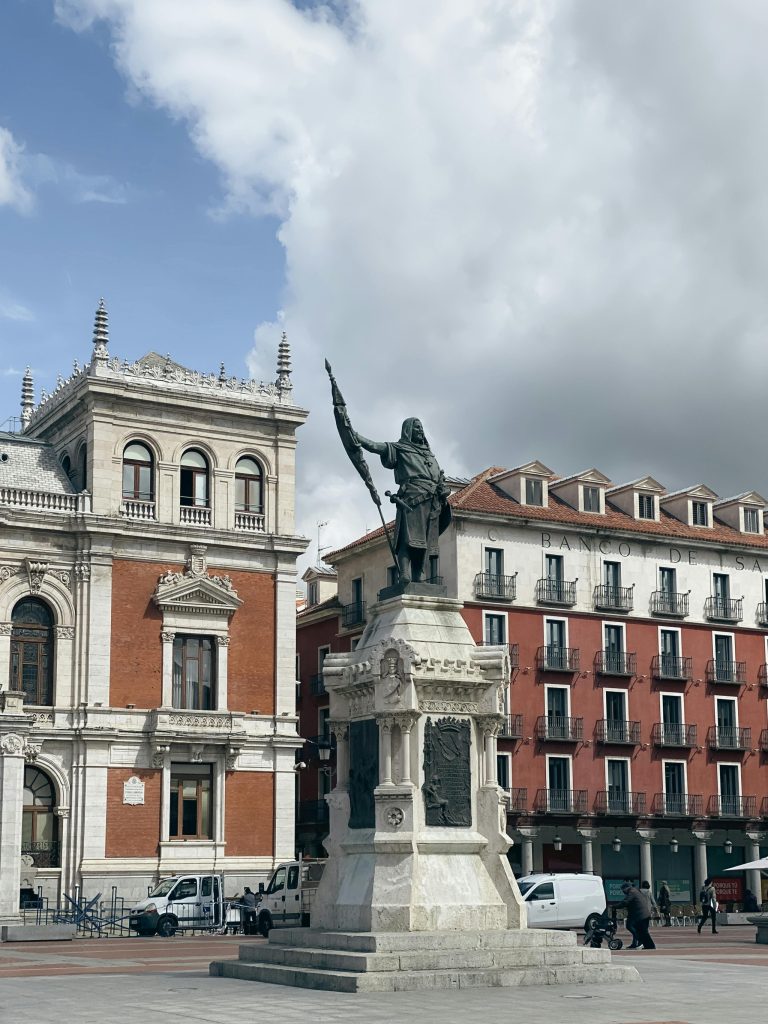
Valladolid: Estimated Cost of Living for a Family of Four (2025)*
A family of four in Valladolid can expect to spend approximately €2,600–€3,400/month, including:
- Rent for a 3-bedroom furnished apartment: €850–€1,300
(based on central neighborhoods like Centro, La Circular, or Parquesol) - Essentials: groceries, utilities, internet, public transportation, dining out, and healthcare
- Education: public schools are free; few private options available
Best For: Families who want a slower pace, deep cultural immersion, and low cost of living — and who are comfortable living in a mostly Spanish-speaking environment with less reliance on international infrastructure.
Seville: Rich Culture, Affordable Living, and a Slower Pace for Families
Seville (Sevilla) might not be the first city that comes to mind for expat families moving to Spain — but it probably should be. When we visited, I was surprised by how much it had to offer for families like mine. It’s walkable, beautiful, full of green spaces, and rich in history and culture. Compared to other major Spanish cities, Seville feels slower, warmer (literally and figuratively), and more connected to tradition — while still offering many modern amenities.

The city’s colorful architecture, lively plazas, and kid-friendly parks make it an inspiring place to raise children. We felt incredibly safe walking around, and while the summer heat was intense, the rhythm of life adjusts — with long lunch breaks, shaded courtyards, and a general emphasis on enjoying the moment. It also helps that Seville has a lower cost of living than most large Spanish cities, especially when it comes to rent.
Why Families Love It
- Great quality of life for the cost: Compared to cities like Madrid or Valencia, Seville offers more square footage and a lower price tag — even in central neighborhoods like Los Remedios or El Porvenir.
- Strong cultural identity: From flamenco performances to local festivals, Seville is a wonderful place for kids to grow up immersed in art, music, and tradition.
- Green spaces and walkability: Parks like Parque de María Luisa and the riverside paths near Triana give families space to roam and relax.
- Good schooling options: While fewer than in Madrid or Barcelona, there are still international and bilingual schools available.
- Well-connected for travel: High-speed AVE trains connect Seville to Madrid in under 3 hours, and Seville’s airport has flights across Europe.
What to Consider
- Extreme summer heat: Temperatures can exceed 40°C (104°F) in July and August — families sensitive to heat may need to adjust their routine or plan to travel during the hottest months.
- Fewer international schools: While options exist, they are more limited compared to cities like Barcelona or Valencia.
- Less English spoken: Especially in local government offices or smaller businesses — you’ll need at least basic Spanish.
- Tourism: While less intense than in Barcelona, the city center can still get crowded in high season.
Seville: Estimated Cost of Living for a Family of Four (2025)
A family of four in Seville can expect to spend approximately €3,100–€4,000/month, including:
- Rent for a 3-bedroom furnished apartment: €1,200–€1,700
(based on neighborhoods like Los Remedios, El Porvenir, or Triana) - Essentials: groceries, utilities, internet, public transportation, dining out, and healthcare
- Education: public schools are free; private bilingual school options available
Best For: Families looking for a culturally rich city with affordable living, good weather (with the exception of summer), and a slower, more traditional pace of life — without sacrificing safety, services, or connection to the rest of Spain.
How to chose the right city for you from this list of the best cities in Spain for expat families
If you’re planning to move to Spain as a family while working remotely or freelancing, the good news is that you have a lot of great options. From the cultural energy of Madrid and Barcelona to the laid-back Mediterranean lifestyle in Valencia, Alicante, or Malaga — and even lesser-known gems like Zaragoza and Valladolid — Spain offers a wide range of cities that can support your family’s values, routines, and dreams. And that is why we create this list of best cities in Spain for expat families, so that you can start narrowing down what cities are a good fit for you.
While the Spain Digital Nomad Visa (DNV) has opened the door for remote workers and their dependents, choosing the best city in Spain for expat families is important as getting your visa approved. Cost of living, walkability, schools, healthcare, climate, and housing availability (especially for families with pets!) can make a huge difference in your quality of life abroad.
Best for vibrant city life, culture, and top-tier education: Madrid or Barcelona
Big-city families will appreciate world-class museums, international schools, major universities, and excellent healthcare — all in cities with thriving global communities.
- Best for family-friendly living with pets and outdoor space: Valencia or Malaga
Both cities offer a strong balance of green spaces, walkability, and pet-friendly neighborhoods. Valencia is especially known for its sustainability and access to nature within the city, while Malaga shines with coastal hikes and a laid-back vibe. - Best for affordability, local charm, and slower living: Valladolid or Zaragoza
These mid-sized cities are calm, culturally rich, and ideal for Spanish-speaking families who want to avoid the tourist bustle and stretch their budget. - Best for coastal living without breaking the bank: Alicante or Tenerife
Sun-soaked and relaxed, these cities offer Mediterranean or island lifestyles with strong expat support, international schools, and lower housing costs. - Best for nature access with progressive values and walkability: Granada or Bilbao
From hiking trails to green city initiatives, both cities provide nature at your doorstep along with vibrant local culture and strong public systems. - Best for traditional Andalusian charm with city comforts: Seville
Seville blends Moorish architecture, rich cultural traditions, and a warm climate with excellent schools, strong healthcare, and a walkable city center — all in a more affordable package than Madrid or Barcelona.
There’s no one-size-fits-all answer when it comes to the best cities in Spain for expat families, but there is a right fit for your family. Whether you’re prioritizing neurodiversity support, LGBTQ+ inclusion, walkability, bilingual education, or simply finding a city where your dog will be welcome, Spain offers a path to a better, more balanced life.
Ready to take the next step? Be sure to check out our in-depth article on the Best Digital Nomad and Freelancer Visas in Europe for Families (2025) for more insights on Spain’s visa process and how to choose the country — and city — that’s right for you.
*Note: The cost of living breakdowns for each city are average estimates and may vary based on location, lifestyle, apartment type, and season. Some neighborhoods will be more expensive; while other neighborhoods can be more budget-friendly.
- Cranberry Brie Cake Grazing Board (An Elegant Holiday Cheese Centerpiece) - December 19, 2025
- Easy Cranberry Cocktails You Can Make All Year - December 18, 2025
- Christmas Mulled Wine (A Classic Holiday Mulled Wine Recipe) - December 18, 2025


